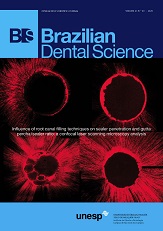Effect of SiO2 and Al2O3 nanoparticles on wear resistance of PMMA acrylic denture teeth
DOI:
https://doi.org/10.14295/bds.2020.v23i3.1999Abstract
Objective: This study aimed to evaluate the wear resistance of acrylic denture teeth containing silicon dioxide (nano-SiO2) and aluminum dioxide (nano-Al2O3) nanoparticles. Material and Methods: Poly methyl methacrylate (PMMA) denture tooth material was used to denture tooth material was used to fabricate 84 specimens (n=10) containing nano-SiO2 and nano-Al2O3 in concentrations 0.1wt%, 0.3wt%, and 0.5wt% of acrylic powder. A two-body wear testing machine and digital microscope were used to measure the changes in weight loss and surface roughness respectively. One-way ANOVA and pair-wise Tukey’s post-hoc tests were used for data analysis (? = 0.05). Results: Nano-SiO2 modified teeth material demonstrated a significant increase in weight loss in comparison conventional artificial acrylic teeth material (p ? 0.05) while nano- Al2O3 modified teeth material demonstrated non-significant increase in weight loss except for 0.5% subgroup (p ? 0.05). There is no significant differences regarding roughness change after wear simulation among all tested groups (p > 0.05). Conclusion: Nano-Al2O3 nanoparticles exhibit less negative effect than nano-SiO2 so; it could be used with caution if necessary.
Keywords
Acrylic denture teeth; Al2O3 nanoparticles; SiO2 nanoparticles; wear resistance; surface roughness.
Downloads
References
Munshi N, Rosenblum M, Jiang S, Flinton R. In vitro wear resistance of nano-hybrid composite denture teeth. J Prosthodont. 2017;26(3):224–9. doi:10.1111/jopr.12412.
Preis V, Hahnel S, Behr M, Rosentritt M. Contact wear of artificial denture teeth. J Prosthodont Res. 2018;62(2):252–7. doi:10.1016/j.jpor.2017.11.001.
Suzuki S. In vitro wear of nano-composite denture teeth. J Prosthodont. 2004;13(4):238–43. doi:10.1111/j.1532-849X.2004.04043.x.
Stober T, Henninger M, Schmitter M, Pritsch M, Rammelsberg P: Threebody wear of resin denture teeth with and without nanofillers. J Prosthet Dent. 2010; 103:108-17.
Ghazal M, Yang B, Ludwig K, Kern M. Two-body wear of resin and ceramic denture teeth in comparison to human enamel. Dent Mater. 2008;24(4):502–7. doi:10.1016/j.dental.2007.04.012.
Zeng J, Sato Y, Ohkubo C, Hosoi T. In vitro wear resistance of three types of composite resin denture teeth. J Prosthet Dent. 2005;94(5):453–7. doi:10.1016/j.prosdent.2005.08.010.
Hao Z, Yin H, Wang L, Meng Y. Wear behavior of seven artificial resin teeth assessed with three-dimensional measurements. J Prosthet Dent. 2014;112(6):1507–12. doi:10.1016/j.prosdent.2014.04.030.
Loyaga-Rendon PG, Takahashi H, Hayakawa I, Iwasaki N. Compositional characteristics and hardness of acrylic and composite resin artificial teeth. J Prosthet Dent. 2007;98(2):141–9. doi:10.1016/S0022-3913(07)60047-X
Stober T, Lutz T, Gilde H, Rammelsberg P. Wear of resin denture teeth by two-body contact. Dent Mater. 2006;22(3):243–9. doi:10.1016/j. dental.2005.03.009.
Gad MM, Fouda SM, Al-Harbi FA, Näpänkangas R, Raustia A. PMMA denture base material enhancement: a review of fiber, filler, and nanofiller addition. Int J Nanomedicine. 2017;12:3801–12. Published 2017 May 17. doi:10.2147/IJN.S130722.
Gad MM, Rahoma A, Abualsaud R, Al-Thobity AM, Akhtar S, Helal MA, et al. Impact of different surface treatments and repair material reinforcement on the flexural strength of repaired PMMA denture base material [published online ahead of print, 2020 Feb 21]. Dent Mater J. 2020;10.4012/ dmj.2018-436. doi:10.4012/dmj.2018-436.
Balos S, Pilic B, Markovic D, Pavlicevic J, Luzanin O. Poly(methylmethacrylate) nanocomposites with low silica addition. J Prosthet Dent. 2014;111(4):327–34. doi:10.1016/j.prosdent.2013.06.021.
Alnamel AH, Mudhafer M. The effect of silicon di oxide nanofiller reinforcement on some properties of PMMA material. J BaghColl dent 2014; 26:32-38.
Akkus B, Ozturk AN, Yazman S. Effects of Al 2 O 3 and SiO 2 nano particles on flexural strength of heat cured acrylic resin. Int J Enhanc Res Sci Technol Eng 2015;6:158-63.
Vojdani M, Bagheri R. Effects of aluminum oxide addition on the flexural strength, surface hardness, and roughness of heat-polymerized acrylic resin. J Dent Sci 2012;7(3):238-44. doi: https://doi.org/10.1016/j. jds.2012.05.008.
Jaber MA. Effect of alumina oxide addition on the surface roughness and hardness of acrylic resin denture base. Tikrit J Dent Sci 2015;32-8.
Jasim BS, Ismail IJ. The Effect of Silanized Alumina NanoFillers Addition on Some Physical and Mechanical Properties of Heat Cured Polymethyl Methacrylate Denture Base Material. Restorative Dentistry Serb chem Soc J 2014; 26:18-23.
International Standards Organization. ISO/TS 14569-2: 2001 (E). Dental materials-guidance on testing of wear – part 2: wear by two- and/or three body contact [Internet]. Geneva: ISO; 2001 [cited 2020 mes dia]. Available from: http://webstore.ansi.org.
Ola M, Sakr. Er: YAG Laser assisted bleaching procedures effect on enamel topography. Inter J Dent Sci Res. 2018; 6(2):39-42. doi: 10.12691/ijdsr-6-2-4.
Ho TK, Satterthwaite JD, Silikas N. The effect of chewing simulation on surface roughness of resin composite when opposed by zirconia ceramic and lithium disilicate ceramic. Dent Mater. 2018;34(2):e15–e24. doi:10.1016/j.dental.2017.11.014
Suwannaroop P, Chaijareenont P, Koottathape N, Takahashi H, Arksornnukit M. In vitro wear resistance, hardness and elastic modulus of artificial denture teeth. Dent Mater J. 2011;30(4):461–8. doi:10.4012/ dmj.2010-200.
Ilangkumaran R, Srinivasan J, Baburajan K, Balaji N. Two Body Wear of Newly Introduced Nanocomposite Teeth and Cross Linked Four Layered Acrylic Teeth: a Comparitive In Vitro Study. J Indian Prosthodont Soc. 2014;14(Suppl 1):126–31. doi:10.1007/s13191-014-0381-z.
Abe Y, Sato Y, Akagawa Y, Ohkawa S. An in vitro study of high-strength resin posterior denture tooth wear. Int J Prosthodont. 1997;10(1):28–34.
Hahnel S, Behr M, Handel G, Rosentritt M. Two-body wear of artificial acrylic and composite resin teeth in relation to antagonist material. J Prosthet Dent. 2009;101(4):269–78. doi:10.1016/S0022-3913(09)60051-2.
Condon JR, Ferracane JL. In vitro wear of composite with varied cure, filler level, and filler treatment. J Dent Res. 1997;76(7):1405–11. doi:10.1177/0022 0345970760071101.
O’Brien WJ, Yee J Jr. Microstructure of posterior restorations of composite resin after clinical wear. Oper Dent. 1980;5(3):90–4.
Vojdani M, Bagheri R, Khaledi AR. Effects of aluminum oxide addition on the flexural strength, surface hardness, and roughness of heatpolymerized acrylic resin. J Dent Sci 2012;7(3):238-44. doi: https://doi. org/10.1016/j.jds.2012.05.008
Downloads
Published
How to Cite
Issue
Section
License
Brazilian Dental Science uses the Creative Commons (CC-BY 4.0) license, thus preserving the integrity of articles in an open access environment. The journal allows the author to retain publishing rights without restrictions.
=================




























